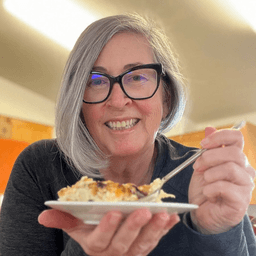62-Year-Old Blogger Hits $300K/Year with Easy Recipes & Accountability Partner


Business Description
Table of Contents
Navigate through the case study sections
Executive Summary
Case Study Content
Introduction
In 2013, Debra Clark began Bowl Me Over just to share her favorite recipes with friends. She didn’t imagine it would one day support her family or attract hundreds of thousands of monthly visitors. But over a decade of steady improvements, she transformed that hobby into a full-time business that now pulls in about $300,000 a year. This case study dives into the steps she took, from sharpening her writing and photography to building daily habits around SEO and reader engagement, that drove her growth. You’ll also see how partnering weekly with another blogger kept her accountable and on track.
The Early Steps
At first, Debra posted new recipes whenever she felt inspired, mostly on Facebook. She quickly realized site visitors needed clear instructions and appealing photos. She invested time in learning simple food photography, writing posts that were easy to skim, and picking topics people actually searched for. Instead of guessing, she tried different formats, like one-pot meals, make-ahead salads, or slow-cooker dishes, to see what resonated with early readers. Gradually, she refined her focus to “everyday recipes” that busy home cooks could tackle without specialty ingredients.
Building Key Skills
Debra taught herself three vital areas: writing, photography, and SEO. She practiced writing engaging headlines, split text into bite-size sections, and added personal stories to keep readers connected. For food photos, she experimented with natural light and simple backgrounds until her images looked mouth-watering. And for SEO, she spent evenings using tools like Search Console and Google Analytics to track performance, tweak keywords, and update older posts. Every recipe got tested in her own kitchen before going live.
Organizing Content & Engagement
Instead of waiting for readers to stumble on her site, Debra built an email list through a pop-up offering a free weeknight dinner plan. She uses ConvertKit to send daily newsletters featuring 9–12 recipes. At first it felt odd emailing that often, but subscribers came to expect Debra’s messages and wrote back with feedback. She also linked new posts to three older recipes to keep people exploring, and shared each launch on Facebook, Twitter, and Pinterest to tap into social traffic.
SEO Strategy
Because search engines drive most visits, Debra does small SEO tasks every day. She checks Google Search Console for keyword trends, updates meta descriptions, and refreshes content on posts that have slipped in the rankings. When Google rolled out a big algorithm change in 2023, her traffic plunged from 307,000 to 129,000 clicks in a month. She didn’t panic. Instead, she audited her posts, improved clarity, added more step-by-step photos, and worked with her accountability partner to test new titles and formats. Within weeks, traffic rebounded.
The Power of Reader Feedback
Rather than create recipes in isolation, Debra asks subscribers what they need most, 100-calorie snacks, five-ingredient dinners, or freezer-friendly meals. Early on, she heard almost nothing back. But by sharing little bits of her life and answering every email, she opened two-way communication. Now she gets dozens of replies weekly, which she uses to spark new posts. Readers trust that every recipe is tested and easy, so they’re more likely to click through and share.
Accountability Partner
A game-changer was teaming up with Marye from the Restless Chipotle blog. They meet weekly on Zoom to review goals, troubleshoot slow-growing posts, and push each other to try new tactics. Once a year they gather in Phoenix for a planning retreat, where they brainstorm topics and map out content calendars. Honest feedback, sometimes blunt, helped Debra stay focused and keep improving when it was tempting to coast.
Monetization & Ad Strategy
Ads now cover most of Debra’s revenue. In March 2024 she switched from Mediavine to Raptive after seeing flat RPMs and little guidance. Raptive guaranteed an uplift, and her ad income rose immediately. She continues to test ad layouts, balancing user experience with ad revenue to hit that $25K-a-month target without turning off her audience.
Results & Takeaways
Today Bowl Me Over pulls in around 400,000 readers monthly and $300,000 a year. Debra’s husband Dan retired two years ago to taste-test every recipe. They moved from California to Oregon and bought a new home, all funded by her blog. Her story shows that with clear focus on audience needs, daily SEO habits, consistent content, and a partner to keep you honest, a simple hobby can become a thriving online business.
Key Takeaways
- 1Debra started Bowl Me Over as a hobby in 2013 and turned it into a full-time business over ten years of steady skill building.
- 2She focuses exclusively on easy, everyday recipes tested personally, building trust with home cooks.
- 3Daily SEO maintenance, updating titles, refreshing content, tracking trends, helped recover from a 58% traffic drop.
- 4Her daily newsletters via ConvertKit with 9-12 recipes keep subscribers engaged and reduce reliance on search engines.
- 5Weekly meetings with an accountability partner provided honest feedback, fresh ideas, and kept her goals on track.
- 6Switching ad networks from Mediavine to Raptive boosted RPMs and stabilized her ad revenue.
Key Facts
Tools & Technologies Used
Premium Content Locked
Subscribe to access the tools and technologies used in this case study.
Unlock NowHow to Replicate This Success
Premium Content Locked
Subscribe to access the step-by-step replication guide for this case study.
Unlock NowInterested in Being Featured?
Share your success story with our community of entrepreneurs.
Explore More Case Studies
Discover other inspiring business success stories

How MySignature Bootstrapped to $700K ARR with SEO
MySignature began as a simple idea: replace tedious manual email signatures with a user-friendly, browser-based generato...
MySignature

How OnlyFans Model Yulia Poddubnaya Scaled Her Income to $3,500/Month
Yulia Poddubnaya shares her OnlyFans story, experiencing early setbacks on Twitter before finding success through an aff...
Yulia Poddubnaya OnlyFans

How a Blogger Turned $127 Into $593 in Just 7 Days with Facebook Arbitrage
When blogger Hasib Alic spent only $127 on Facebook ads and walked away with $593 in Mediavine payouts in just seven day...
Hasib Alic Blog